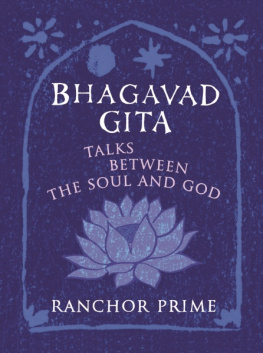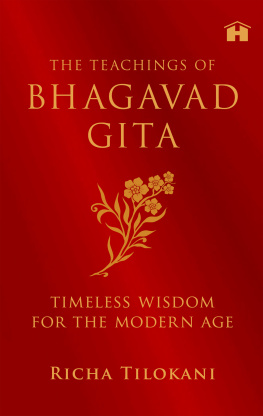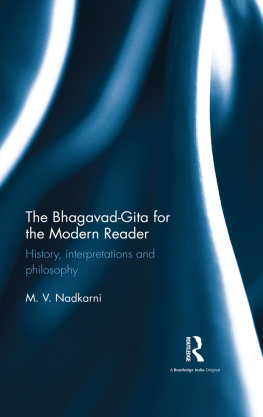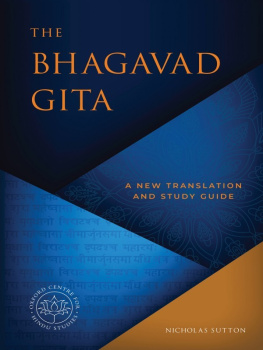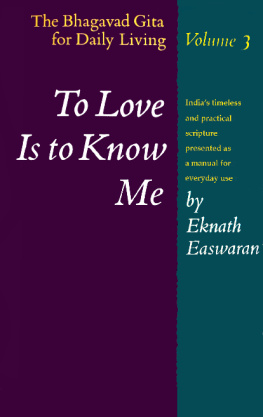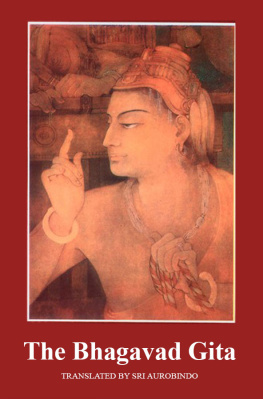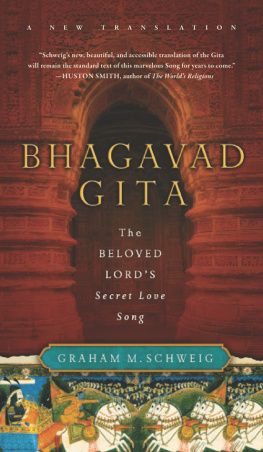by the same author:
Hinduism and Ecology
Ramayana: A Journey
Vedic Ecology
Prince of Dharma: the Buddha
Mahavira: Prince of Peace
Hinduism
Cows and the Earth
When the Sun Shines
First published as The Illustrated Bhagavad Gita
by Godsfield Press 2003
New revised edition published by Fitzrovia Press 2010
First e-book edition 2010
Text copyright Ranchor Prime 2003, 2010
Illustrations copyright Charles Newington 2010
Fitzrovia Press
Grafton Mews
London W1T 5JG
www.fitzroviapress.co.uk
ISBN 978095618468-9
Dedication
For my teacher,
Srila Prabhupada,
who introduced me to Krishna,
and for my children Rupi and Anasuya,
whose questions inspired this book
Ranchor Prime is an author, artist, publisher and broadcaster. After living in ashrams in Britain and India, he worked for 20 years as an environmental project manager for the World Wide Fund for Nature and advisor to the Alliance of Religions and Conservation. He has published ten books on ecology and spirituality, including Ramayana A Journey, Hinduism and Ecology and Cows and the Earth.
Charles Newington is a painter, printmaker and illustrator, most well know as the creator of The White Horse of Folkestone, a giant hill figure above the Channel Tunnel entrance. His latest exhibition of paintings, inspired by St Johns Book of Revelation, was held at the Atlantis Bookshop Gallery, London, in October 2009.
www.charlesnewington.com
Table of Contents
|
|---|
| one |
| two |
| three |
| four |
| five |
| six |
|
|---|
| seven |
| eight |
| nine |
| ten |
| eleven |
| twelve |
|
|---|
| thirteen |
| fourteen |
| fifteen |
| sixteen |
| seventeen |
| eighteen |

Introduction
O Krishna, tell me again of your mystic opulences,
for I never tire of hearing your sweet words.
Bhagavad Gita, 10.18

rishnas words in the Bhagavad Gita are the finest introduction to the spiritual tradition of India. Yet like the sun which rises in the East and shines everywhere, they belong to the whole world. When I first heard Krishnas voice, it reached me as an echo from a distant land, from a civilisation that remembered truths lost in our divided and confused age. I had been brought up to revere the voice of God in the Bible, and until then I had not heard about Krishnas words in the Gita . Here was the same unmistakable voice of the universal God; I indeed felt the book fulfilled its name: Bhagavad Gita means Song of God.
The Gita is special among Eastern spiritual teachings because it shows how the experience of God can be found in the ordinary actions of everyday life. This sense of the mystical presence was often supposed to be only for those who foresook the world for a life of prayer and meditation, who lived apart from the rest of us in privileged seclusion. The Gita , however, offers this experience to us all, encouraging us to remain in the world and to find God in the practice of our daily work. Such awareness calls us to live in the sanctity of every moment and brings with it the possibility of finding great spiritual joy.
The Gita is arranged as a conversation between the soul and God, who appear to us as Arjuna and Krishna. In life they were friends, and the Gita makes great play of this: spiritual understanding is found through friendship and trust, and ultimately through love. The dialogue of these two friends invites exploration and deep reflection; it is always ready to tell us more, even after many readings. One of the Gita s best-known proponents of the twentieth century was Mahatma Gandhi. He wrote, When doubts haunt me and I see not one ray of hope on the horizon, I turn to the Gita and find a verse to comfort me.
How old is the Gita ? For the spiritual seeker it matters little, for its knowledge is born of eternity, and it is as alive today as it was when it was first spoken. Most modern scholars suppose it achieved its present Sanskrit form around 500 BC, but the Vedic tradition tells us it is much older, and that Krishna originally spoke the Gita five thousand years ago.
The Gita occupies a unique place as the one universally accessible text acknowledged by all Hindus. Krishnas message of love, based upon the teachings of the worlds earliest body of philosophical writings, the Vedas and Upanishads , draws together the sublime philosophy of the Upanishads with the practical path of yoga. It unites the outer world, in which the soul is immersed in the inconceivable energies of God, with the inner world where the soul sits side by side with the divine person. So the Gita brings us to the ultimate conclusion of surrender to a loving God.
By the middle of the first millennium AD, the Gita was adopted by Hindu teachers as their standard popular text. In around 800 AD it was singled out by the great Shankara for his famous commentary. All the principal Hindu teachers later commented on it, each according to their particular viewpoint. It was first translated into English by Charles Wilkins in 1785, and has since been published in numerous English editions. Henry David Thoreau wrote in 1854 of the stupendous and cosmogonal philosophy of the Bhagavad Gita . Thomas Merton in the 1960s saw the Gita like the Gospels, teaching us to live in awareness of an inner truth. In obedience to that inner truth we are at last free. Aldous Huxley described the Gita as one of the clearest and most comprehensive summaries of the Perennial Philosophy ever to have been made. Hence its enduring value, not only for Indians, but for all mankind.
Spirit of humility
The speaker of the Bhagavad Gita is Krishna, who reveals himself to be the supreme godhead. Krishna is the central figure in the vast Mahabharata , the epic history of ancient India, of which the Gita is but one episode. Krishnas teaching opens on the brink of a cataclysmic battle, the events of which are recounted in the Mahabharata . Krishna is asked by his personal friend, the warrior Arjuna, to drive his chariot into the space between the two opposing armies. Once he finds himself in the midst of both armies Arjuna despairs and lays down his arms. He turns to Krishna for spiritual help.
Arjunas despair is due to the awful prospect of having to kill his own friends and family members, who stand in the opposing army. It is said that Arjuna is an enlightened soul placed in illusion by Krishna, and his experience thus parallels our own: God allows us to fall into the illusion of material life, so that we can better learn who we really are and who we wish to be. The physical site where the Gita was spoken is Kurukshetra, eighty miles north of Delhi; but the spiritual place where it can be heard, that inner space of emptiness and doubt, is one we all know.
We all have our battles to fight, brought on by illusion. The most difficult battle is the one we wage daily with our own mind and senses. But even in the midst of adversity we must find the time to pause, as Arjuna did between the opposing armies, to contemplate the mysteries of life and what it is we really seek, opening ourselves to hear the voice of the spirit. In order to do this, to make this radical shift in awareness, we need help. When reading the Gita we should remember that it is spoken in such a rare moment to one who has put aside certainty and pride. The spirit of humility that allows us to ask for help is easier to speak of than to practice; yet to learn spiritual truths it is essential to open the heart.

